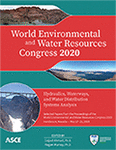World Environmental and Water Resources Congress 2020
Analysis of Equilibrium Morphologies Downstream of a PK Weir Structure
Publication: World Environmental and Water Resources Congress 2020: Hydraulics, Waterways, and Water Distribution Systems Analysis
ABSTRACT
Scour processes downstream of hydraulic structures are some of the more challenging problems for hydraulic engineers because of the potential for scour to cause incidents and failures with catastrophic consequences to society and the surrounding environment. In addition, urbanization and climate changes frequently cause flow capacity deficiencies for various hydraulic structures to safely pass extreme flood events and meet current regulations. In this regard, PK weirs represent an innovative control structure that can be successfully used in new and rehabilitation projects to fulfill this trend of increasing discharge capacity demand. Nevertheless, the effects of an increased discharge on local scour are still under-explored. In order to fulfil this gap of knowledge, a dedicated laboratory model was built and experimental tests were conducted to analyse the scour mechanism downstream of a PK weir structure. One uniform noncohesive granular bed material was tested under different combinations of discharge and tailwater depth. This paper presents a preliminary analysis of the scour morphology downstream of a PK weir, focusing on the effects of different tested variables at equilibrium conditions.
Get full access to this article
View all available purchase options and get full access to this chapter.
REFERENCES
Blanc, P., and F. Lempérière. 2001. “Labyrinth spillways have a promising future.” Int. J. Hydropower Dams. 8 (4): 129–131.
Bombardelli, F.A., Palermo, M., and S. Pagliara. (2018). “Temporal evolution of jet induced scour depth in cohesionless granular beds and the phenomenological theory of turbulence.” Physics of Fluids, 30, 085109, 1-19.
Bormann, N. E., and P. Y. Julien. 1991. “Scour downstream of grade-control structures.” J. Hydraul. Eng. 117 (5): 579–594. https://doi.org/10.1061/(ASCE)0733-9429(1991)117:5(579).
Crookston, B. M., Erpicum, S., Tullis, B.P., and F. Laguier. (2019). “Hydraulics of labyrinth and piano key weirs: 100 years of prototype structures, advancements, and future research needs.” J. Hydraul. Eng. 145(12): 02519004. https://doi.org/10.1061/(ASCE)HY.1943-7900.0001646.
D’Agostino, V., and V. Ferro. 2004. “Scour on alluvial bed downstream of grade-control structures.” J. Hydraul. Eng. 130 (1): 24–37. https://doi.org/10.1061/(ASCE)0733-9429(2004)130:1(24).
Jüstrich, S., Pfister, M., and A. J. Schleiss. (2016). “Mobile riverbed scour downstream of a piano key weir.” J. Hydraul. Eng. 142(11): 04016043. https://doi.org/10.1061/(ASCE)HY.1943-7900.0001189.
Meftah, M. B., and M. Mossa (2019). “New approach to predicting local scour downstream of grade-control structure.” J. Hydraul. Eng. 146(2): 04019058. https://doi.org/10.1061/(ASCE)HY.1943-7900.0001649.
Pagliara, S., and M. Palermo. (2008). “Plane plunge pool scour with protection structures.” Journal of Hydro-Environment Research, 2(3), 182-191.
Pagliara, S., Hager, W.H., and J. Unger. (2008) “Temporal evolution of plunge pool scour.” Journal of Hydraulic Engineering, 134(11), 1630-1630.
Pagliara, S., Palermo, M., and R. Das. (2016) “Eco-Friendly Countermeasures for Enlarged Basins Erosion.” River Research and Applications, 32(3), 441-451.
Pagliara, S., Palermo, M., Mahmoudi Kurdistani, S., and L. Hassanabadi. (2015) “Erosive and hydrodynamic processes downstream of low-head control structures.” Journal of Applied Water Engineering and Research, 3(2), 122-131.
Pagliara, S., Roy, D., and M. Palermo. (2010). “3D plunge pool scour with protection measures.” Journal of Hydro-Environment Research, 4(3), 225-233.
Palermo, M., Bombardelli, F.A., and S. Pagliara. (2018). “From developing to developed phase in the scour evolution due to vertical and sub-vertical plunging jets: new experiments and theory.” Proc. 7th IAHR International Symposium on Hydraulic Structures, Aachen, Germany, D. Bung, and B. Tullis (Eds.), 8 pages.
Palermo, M., Pagliara, S., and F. A. Bombardelli. (2019). “A theoretical approach for shear stress estimation at 2D equilibrium scour holes in granular material due to sub-vertical plunging jets.” Journal of Hydraulic Engineering, in press.
Pfister, M., Jüstrich, S., and A.J. Schleiss. (2017). “Toe-scour formation at piano key weirs.” In Labyrinth and piano key weirs III: PKW 2017, edited by S. Erpicum, F. Laugier, M. Ho, and M. Pfister, 37–51. London: CRC Press.
Viollet, P. (2007). Water Engineering in Ancient Civilizations. 5,000 Years of History. (Translation from French by F.M. Holly). IAHR, Intagrif, Spain.
Information & Authors
Information
Published In
World Environmental and Water Resources Congress 2020: Hydraulics, Waterways, and Water Distribution Systems Analysis
Pages: 43 - 51
Editors: Sajjad Ahmad, Ph.D., and Regan Murray, Ph.D.
ISBN (Online): 978-0-7844-8297-1
Copyright
© 2020 American Society of Civil Engineers.
History
Published online: May 14, 2020
Published in print: May 14, 2020
Authors
Metrics & Citations
Metrics
Citations
Download citation
If you have the appropriate software installed, you can download article citation data to the citation manager of your choice. Simply select your manager software from the list below and click Download.
